
Today I want to dive into the world of air travel superstars: the international hub airports that that boast the highest passenger traffic. These airports are like magnets for travelers from around the globe. Some are well-known for their worldwide connections, while others smartly sit close to city centers, making travel super easy.
Let’s have a look at the Top 10 busiest airports in the world in 2022 based on the total passenger traffic numbers. Data for passenger numbers was gathered from Airports Council International (ACI) World - “The top 10 busiest airports in the world revealed”.
While United States airports persist in dominating half of the Top 10 positions, airports like Dubai International Airport, London Heathrow, and Paris–Charles de Gaulle, which had faded from the elite list in 2021, have made a strong comeback in the year 2022.
10. Paris Charles de Gaulle Airport (CDG/ LFPG), Paris, France
Sprawling across 8,001 acres of land, Paris Charles de Gaulle Airport is situated 23 kilometers northeast of the heart of Paris. Originally inaugurated in 1974, the airport’s location once served as open fields and agricultural grounds. Now, CDG boasts an array of four runways, with the longest extending to 4,200 meters.
Notably, the airport catered to a total of 57.4 million passengers in the year 2022, marking a remarkable 119.4% increase compared to 2021. Paris Charles de Gaulle Airport continues to solidify its status as one of Europe’s premier aviation hubs.
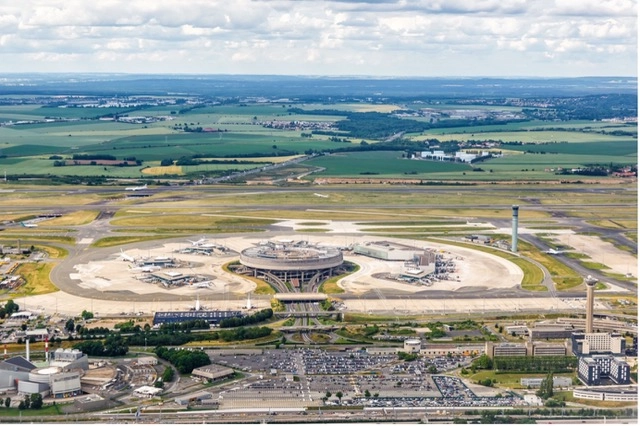
9. Indira Gandhi International Airport (DEL/VIDP), New Delhi, India
Covering an expanse of 5,106 acres, Indira Gandhi International Airport in New Delhi, India, stands as a vital gateway to the subcontinent. Located just 16 kilometers southwest of the bustling heart of Delhi, the airport’s modern facilities have evolved from the land’s historical roots, which once featured open fields and agricultural landscapes.
Originally inaugurated in 1962, the airport has undergone extensive developments to become the sprawling aviation hub it is today. Boasting four parallel runways, the longest extending to a length of 4,430 meters, DEL ensures efficient takeoffs and landings for a diverse range of aircraft.
Notably, the year 2022 marked a significant milestone for Indira Gandhi International Airport, as it welcomed a total of 59.4 million passengers. This notable achievement represented a 60.2% increase compared to the previous year, underscoring the airport’s pivotal role in facilitating travel within India and fostering international connections.

8. Heathrow Airport (LHR/EGLL), London, England
Encompassing 2,999 acres of land, London Heathrow Airport stands as a colossal aviation hub serving the bustling city of London, England. Strategically located just 23 kilometers west of central London, the airport’s origins trace back to its establishment in 1946, when it emerged from pastures and fields that once graced the landscape.
LHR boasts a comprehensive infrastructure, featuring an array of two parallel runways along with an additional runway, with the longest measuring 3,902 meters.
The year 2022 marked a momentous achievement for London Heathrow Airport, as it welcomed a total of 61.6 million passengers. This remarkable milestone reflected a substantial 217.7% increase compared to the previous year, underscoring Heathrow’s enduring significance in connecting the United Kingdom to global destinations.
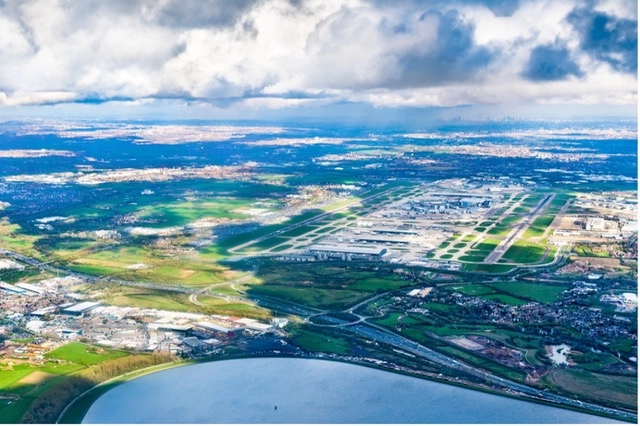
7. Istanbul Airport (IST/LTFM), Istanbul, Turkey
Encompassing a vast expanse of 19,000 acres, Istanbul Airport stands as a monumental aviation complex situated in the Arnavutköy district of Istanbul province, Turkey. Located 54 kilometers northwest of the city center, the airport’s sprawling infrastructure emerged from lands that were once marked by open spaces and natural surroundings.
IST, inaugurated in 2018, represents a marvel of modern engineering and design, serving as a testament to Turkey’s dedication to becoming a global aviation hub. The airport features five runways, with the longest spanning 4,100 meters. Upon its anticipated completion by 2027, the airport’s final configuration will comprise six sets of runways, totaling eight runways in total.
Notably, the year 2022 was a pivotal year for Istanbul Airport, as it welcomed 64.2 million passengers. This achievement marked a significant 73.8% increase compared to 2021, underscoring the airport’s rapid growth and its role in connecting Turkey to destinations worldwide. It is expected that by 2027, the annual passenger capacity will reach 150 million travelers.
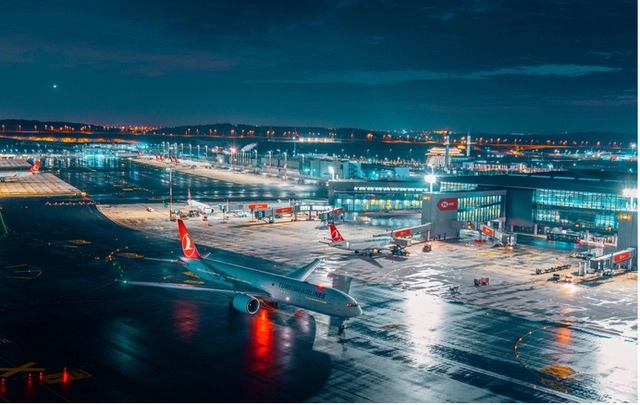
6. Los Angeles International Airport (LAX/KLAX), Los Angeles, California, US
LAX airport is 30 kilometers to the southwest of downtown Los Angeles, covering 3,500 acres. Los Angeles International Airport stands as an iconic aviation hub nestled in the heart of the bustling city of Los Angeles, California.
Originally established in 1928, this airport’s beginnings trace back to a time when it served as farmland for cultivating wheat, barley, and beans. It wasn’t until the late 1950s that the current arrangement of terminals took shape. Prior to that, the airport experienced limited activity, with only sporadic military traffic during wartime.
Los Angeles International Airport boasts four runways, with the longest spanning 3,939 meters. Passenger numbers for 2022 were 65.9 million with a 37.3% increase from 2021. As part of its ongoing expansion, LAX is poised to enhance its infrastructure even further by building two more terminals.
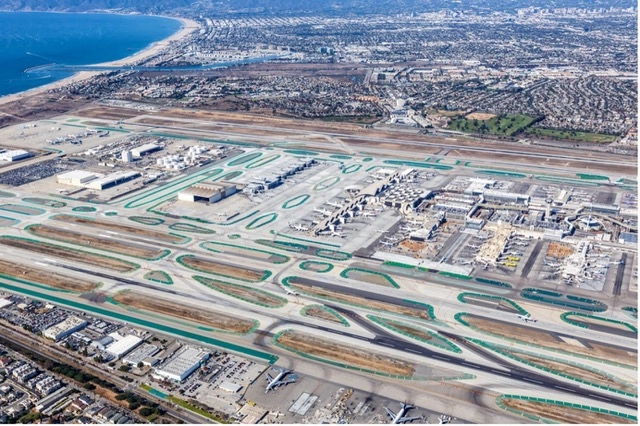
5. Dubai International Airport (DXB/OMDB), Dubai, United Arab Emirates
Covering an area of 7,200 acres, Dubai International Airport stands as a sprawling aviation hub located in the vibrant city of Dubai, United Arab Emirates. Positioned just 4.6 kilometers east of the city center, the airport’s immense infrastructure has evolved from lands that were once characterized by open spaces and sand deserts.
DXB, inaugurated in 1960, has undergone remarkable expansions and renovations, making it one of the world’s busiest and most technologically advanced airports. The facility encompasses two parallel runways, each extending to a length of 4,000 meters.
Notably, Dubai International Airport has consistently showcased its significance as a global transit hub. In 2022, the airport marked a notable achievement by accommodating 66 million passengers. This achievement reflected an impressive 127% increase compared to the previous year, underscoring Dubai’s vital role in connecting the United Arab Emirates to international destinations.
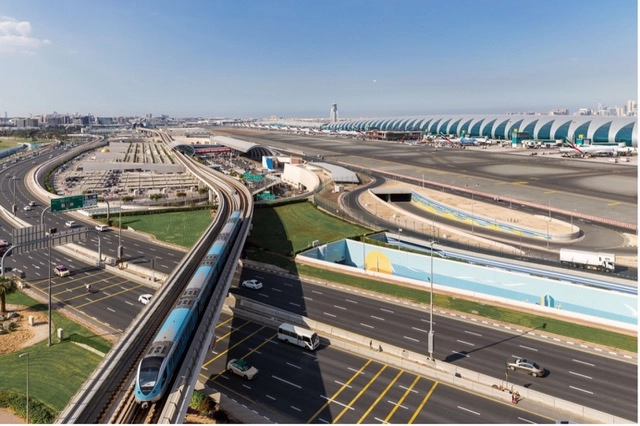
4. Chicago O’Hare International Airport (ORD/KORD), Chicago, Illinois, US
Covering 7,627 acres, Chicago O’Hare International Airport stands as a remarkable aviation hub located in the vibrant city of Chicago, Illinois. Situated 27 kilometers northwest of the city’s downtown area, the airport offers direct flights to over 200 destinations across all continents.
ORD dates back to its opening in 1944. Initially, Chicago O’Hare International Airport started its journey as a manufacturing facility for Douglas C-54 Skymasters during World War Two and was known as the Orchard Field. Later, in 1949, the airport underwent a renaming in honor of O’Hare, and it wasn’t until 1955 that regular passenger services began.
The airport boasts an impressive number of 8 runways, the longest being 3,963 meters long. Total passenger numbers for 2022 were 68.3 million with a 26.5% increase from 2021.
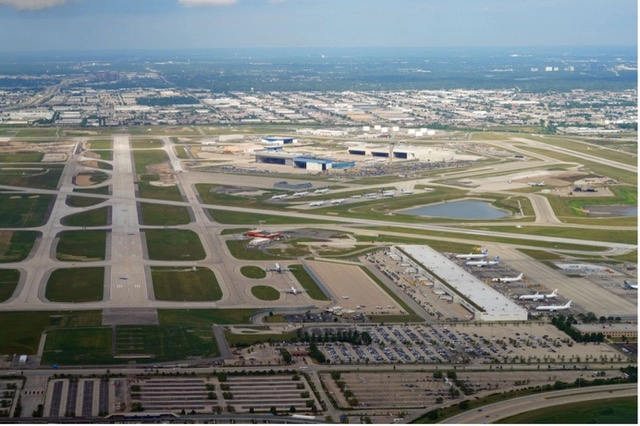
3. Denver International Airport (DEN/KDEN), Denver, Colorado, US
Spanning an impressive 33,531 acres, Denver International Airport takes the lead for the largest land area on this list and is the 2nd biggest airport in the world. Situated in the heart of Denver, Colorado, this aviation hub rests 40 kilometers to the northeast of downtown. Its strategic midpoint position in the US contributes to its consistent bustling activity.
Since its opening in 1995, DEN has become a symbol of top-notch air travel. Originally designed as a cutting-edge response to modern aviation needs, the airport maintains its dedication to innovation and efficiency today. The airport’s iconic tent-like roof structure references the majestic presence of the Rocky Mountains.
The airport boasts 6 runways with the longest measuring an impressive 4,877 meters. It is the longest operational civilian runway in the United States. This extended length is attributed to the airport’s high elevation, where the thinner air requires airplanes to have lengthier runways to ensure safe takeoffs, allowing for adequate wing airflow.
In 2022, Denver International Airport received 66 million, a 17.8% increase from 2021.
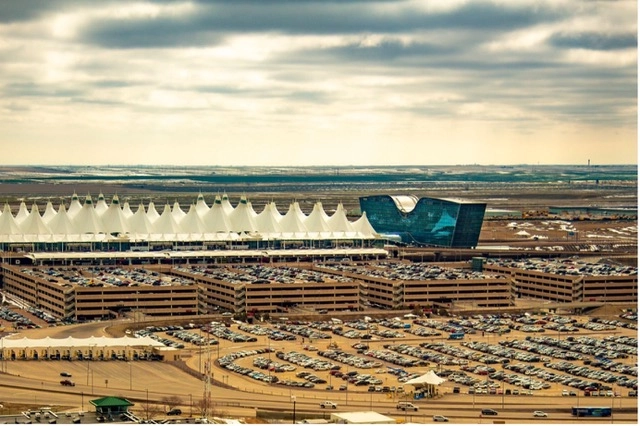
2. Dallas Fort Worth International Airport (DFW/KDFW), Texas, US
Encompassing a vast 27,000 acres, Dallas Fort Worth International Airport stands as a prominent aviation hub nestled in the dynamic city of Dallas, Texas. Situated 24 kilometers to the northwest of downtown.
DFW stands as the primary hub for American Airlines and ranks as the second-largest airline hub globally. The inception of DFW’s construction dates back to 1969, following years of disagreements between Dallas and Fort Worth regarding the collaborative establishment of an airport to cater to both cities. Commercial activities began in 1974, with an American Airlines flight marking the airport’s first landing.
With an impressive array of 7 runways, DFW ensures seamless operations. The longest among them spans an exceptional 4,850 meters. The year 2022 witnessed total passenger traffic of 73.3 million, showcasing a remarkable 17.5% increase from the preceding year. This robust growth underscores Dallas Fort Worth International Airport’s central role in fostering connections, innovation, and progress.
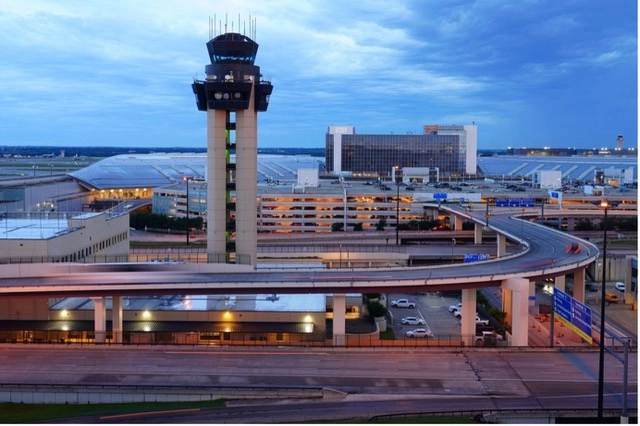
1. Hartsfield-Jackson International Airport (ATL/KATL), Georgia, US
Covering 4,700 acres and positioned just 16 kilometers to the south of downtown Hartsfield-Jackson Atlanta International Airport stands tall as a notable aviation hub nestled within the vibrant city of Atlanta, Georgia.
Hartsfield-Jackson Atlanta International Airport proudly holds the distinction of being the busiest airport in the world in terms of passenger traffic. Its significance stretches even further as a major hub for Delta Air Lines, connecting people across the globe. The airport’s roots trace back to 1926.
ATL has 5 runways, with the longest being 3,776 meters. Since 1998, ATL has consistently held the top spot for the highest passenger traffic globally, relinquishing this position only in 2020 due to COVID-19 restrictions. Total passenger traffic in 2022 was a staggering 93,699,630 passengers, with a 23.8% increase from 2022. Once more, ATL secures its place as the world’s busiest airport by total passenger traffic in 2022.
Top 10 biggest airports in the world by total passenger traffic
| Ranking | Airport | Passenger numbers | Percentage change from 2021 |
|---|---|---|---|
| 1 | Atlanta, Georgia, USA (ATL) | 93 699 630 | 23.8 |
| 2 | Dallas/Fort Worth, Texas, USA (DFW) | 73 362 946 | 17.5 |
| 3 | Denver, Colorado, USA (DEN) | 69 286 461 | 17.8 |
| 4 | Chicago, Illinois, USA (ORD) | 68 340 619 | 26.5 |
| 5 | Dubai, United Arab Emirates (DXB) | 66 069 981 | 127 |
| 6 | Los Angeles California, USA (LAX) | 65 924 298 | 37.3 |
| 7 | Istanbul, Turkey (IST) | 64 289 107 | 73.8 |
| 8 | London, England (LHR) | 61 614 508 | 217.7 |
| 9 | New Delhi, India (DEL) | 59 490 074 | 60.2 |
| 10 | Paris, France (CDG) | 57 474 033 | 119.4 |
Sources:
- https://aci.aero/2022/04/11/the-top-10-busiest-airports-in-the-world-revealed/
- https://paris-airport-cdg.com/
- http://delhicustoms.gov.in/history.html
- https://www.britannica.com/topic/Heathrow-Airport
- http://www.allaboutistanbul.com/airport.html
- https://www.discoverlosangeles.com/travel/a-basic-guide-to-los-angeles-international-airport-lax
- https://daep.gov.ae/our-airports/dubai-international-dxb/
- https://www.hotels.com/go/usa/chicago-ohare-international-airport
- https://www.flydenver.com/about
- https://visitsouthlaketexas.com/about-us/getting-around/airport/dallas-fort-worth-international-airport/
- https://www.atlantahistorycenter.com/exhibitions/atlanta-in-50-objects/hartsfield-jackson-atlanta-international-airport/